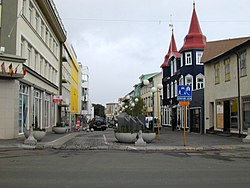Akureyri
Nicknamed the "Capital of North Iceland",[1] Akureyri is an important port and fishing centre.
Further growth occurred after the war as the Icelandic population increasingly moved to urban areas.
The area has a relatively mild climate because of geographical factors, and the town's ice-free harbour has played a significant role in its history.
The Norse Viking Helgi magri (the slim) Eyvindarson originally settled the area in the 9th century.
[4] In the 17th century, Danish merchants based their camps at the current site of Akureyri, which was one of the numerous spits of land in Pollurinn.
The main reasons for choosing this spot for trading operations were the outstanding natural harbour and the fertility of the area.
[11] Hrísey, which has a population of 210, is the second-largest island off Iceland and is a site for pet and livestock quarantine.
[12] The northern part consists of privately owned land that requires passes to enter.
[12] Akureyri is located at 65°41′N 18°06′W / 65.683°N 18.100°W / 65.683; -18.100 and positioned on the west side of the inland end of the fjord Eyjafjörður.
In earlier times, a few spits of land (Icelandic: eyri, thus Akur-eyri) jutted from the narrow coast, but much land has since been reclaimed from the sea, so that today the coastline is more even except for the largest spit, Oddeyri [ˈɔtːˌeiːrɪ], which was formed by the river Glerá, which runs through the town.
[13] The body of sea between Oddeyri and the end of the fjord is known as Pollurinn [ˈpʰɔtlʏrɪn] ("The Pool") and is known for calm winds and a good natural harbour.
Akureyri today is centered on Ráðhústorg [ˈrauðˌhusˌtʰɔrk] (Town Hall Square) near the northwest corner of Pollurinn.
The districts of Akureyri are: Innbær [ˈɪnːˌpaiːr̥], the oldest part of town on the strip of land between the hill and Pollurinn south of the central area; Brekkan [ˈprɛhkan], on top of the hill; Oddeyri on the peninsula of the same name; and Glerárhverfi [ˈklɛːrˌaurˌkʰvɛrvɪ] on the north bank of the Glerá (also referred to colloquially as Þorpið [ˈθɔr̥pɪθ], 'the Village').
Because of the town's position at the head of a long fjord surrounded by high mountains, the climate is more typically inland than coastal, with greater variations in temperature (warmer summers, colder winters) than in many other inhabited parts of Iceland.
[14] The area around Akureyri has one of the warmest climates in Iceland, even though it is only 100 km (62 mi) from the Arctic Circle.
Akureyri is a very cloudy town, averaging only 1,029 sunshine hours annually, with barely any sunshine between November and February (which is also due to the town's location less than 100 km from the Arctic Circle), but precipitation is much lower than in southern Iceland because the prevailing winds are from the south – it is as little as a fifth as much as in Vík í Mýrdal.
Incidents have occurred where insufficient police officers were on duty to respond to criminal activity in progress, as confirmed by the mayor.
[29] Two of the five largest fishing companies in Iceland are headquartered in Akureyri,[13] partly because of the ice-free port.
[5] Other large companies in Akureyri include Samherji, Norðurmjólk, Brim hf, and Vífilfell, the largest brewery in Iceland.
The Akureyri International Music Festival, a concert series by bands, was held for the fourth time in 2009.
[34] The Icelandic National Broadcasting Service (Ríkisútvarpið) operates two radio channels nationwide.
[37] Sites that have been cited as areas of interest include various museums, churches, and the Botanical Gardens.
[15] The Náttúrufræðistofnun Norðurlands (Nature Museum) was opened in 1957 and is in the grounds of the Akureyri Botanical Garden.
Left-Green Movement (Vinstri hreyfingin grænt framboð) and Bright Future (Björt framtíð) each got one seat.
Icelandair flies several times a day to Reykjavík, and there are also domestic flights to Grímsey, Vopnafjörður and Þórshöfn (small settlements in northeast Iceland).
[58] It is also important for freight handling and for tourism, as cruise ships stop in Akureyri during the summer months.
[61] Route 1 or the Ring Road (Þjóðvegur 1 or Hringvegur) connects the town with the other parts of the country, including Reykjavík, which is 390 kilometres (242 miles) away.
It opened for traffic in December 2018, reducing the road distance from Akureyri to Mývatn lake by 16 kilometres (9.9 mi).
[45] Knattspyrnufélag Akureyrar (KA) and Þór Akureyri are the two biggest multi-sport clubs in the town.
The town is also the birthplace of Icelandic footballers Birkir Bjarnason and Aron Gunnarsson, as well as mixed martial arts fighter Gunnar Nelson.










